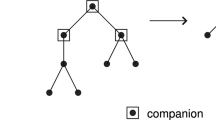Abstract
We here present a dynamic programming algorithm which is capable of calculating arbitrary moments of the Boltzmann distribution for RNA secondary structures. We have implemented the algorithm in a program called RNA-VARIANCE and investigate the difference between the Boltzmann distribution of biological and random RNA sequences. We find that the minimum free energy structure of biological sequences has a higher probability in the Boltzmann distribution than random sequences. Moreover, we show that the free energies of biological sequences have a smaller variance than random sequences and that the minimum free energy of biological sequences is closer to the expected free energy of the rest of the structures than that of random sequences. These results suggest that biologically functional RNA sequences not only require a thermodynamically stable minimum free energy structure, but also an ensemble of structures whose free energies are close to the minimum free energy.
Similar content being viewed by others
References
Benson, D.A., Karsch-Mizrachi, I., Lipman, D., Ostell, J., Wheeler, D., 2004. GenBank: update. Nucleic Acids Res. 32, D23–D26.
Dirks, R., Pierce, N., 2003. A partition function algorithm for nucleic acid secondary structure including pseudoknot. J. Comput. Chem. 24, 1664–1677.
Durbin, R., Eddy, S., Krogh, A., Mitchison, G., 1998. Biological Sequence Analysis: Probabilistic Models of Proteins and Nucleic Acids. Cambridge University Press, Cambridge, UK.
Eppstein, D., Galil, Z., Giancarlo, R., 1988. Speeding up dynamic programming. In: Proc. 29th Symp. Foundations of Computer Science. Assoc. Comput. Mach., pp. 488–496.
Griffiths-Jones, S., 2004. The microRNA registry. Nucleic Acids Res. 32, D109–D111.
Hofacker, I., Fontana, W., Stadler, P., Bonhoeffer, M., Tacker, M., Schuster, P., 1994. Fast folding and comparison of RNA secondary structures. Monatshefte für Chemie 125, 167–188.
Ishitani, R., Nureki, O., Nameki, N., Okada, N., Nishimura, S., Yokoyama, S., 2003. Alternative tertiary structure of tRNA for recognition of a post-transcriptional modification enzyme. Cell 113, 383–394.
Lyngsø, R., Pedersen, C., 2000. Pseudoknots in RNA secondary structures. In: Procceedings of RECOMB. Tokyo, Japan, pp. 201–209.
Lyngsø, R., Zuker, M., Pedersen, C., 1999. Fast evaluation of internal loops in RNA secondary structure prediction. Bioinformatics 15(6), 440–445.
Mathews, D., Sabina, J., Zuker, M., Turner, D., 1999. Expanded sequence dependence of thermodynamic parameters improves prediction of RNA secondary structure. J. Mol. Biol. 288, 911–940.
McCaskill, J.S., 1990. The equilibrium partition function and base pair binding probabilities for RNA secondary structure. Biopolymers 29, 1105–1119.
Meyer, I.M., Miklós, I., 2004. Co-transcriptional folding is encoded within RNA genes. BMC Mol. Biol. 10, 5.
Nebel, M., 2004a. Identifying good predictions of RNA secondary structure. In: Proceedings of the Pacific Symposium on Biocomputing. vol. 9. pp. 423–434.
Nebel, M., 2004b. Investigation of the Bernoulli-model for RNA secondary structures. Bull. Math. Biol. 66(6), 925–964.
Nussinov, R., Jacobson, A., 1980. Fast algorithm for predicting the secondary structure of single-stranded RNA. Proc. Natl. Acad. Sci. USA 77, 6309–6313.
Reeder, J., Giegerich, R., 2004. Design, implementation and evaluation of a practical pseudoknot folding algorithm based on thermodynamics. BMC Bioinformatics 5, 104.
Rivas, E., Eddy, S., 2000. Secondary structure alone is generally not statistically significant for the detection of non-coding RNAs. Bioinformatics 16(7), 583–605.
Sankoff, D., Kruskal, J., Mainville, S., Cedergren, R., 1983. Fast algorithms to determine RNA secondary structures containing multiple loops. In: Sankoff, D., Kruskal, J. (Eds.), Time Warps, String Edits, and Macromolecules: The Theory and Practice of Sequence Comparison. Addison-Wesley, Reading, MA, pp. 93–120.
Szymanski, M., Barciszewska, M.Z., Erdmann, V.A., Barciszewski, J., 2002. 5S ribosomal RNA database. Nucleic Acids Res. 30, 176–178.
Tinoco, I.J., Borer, P., Dengler, B., Levine, M., Uhlenbeck, O., 1973. Improved estimation of secondary structure in ribonucleic acids. Nat. New Biol. 246, 40–41.
Tinoco, I., Uhlenbeck, O.C., Levine, M.D., 1971. Estimation of secondary structure in ribonucleic acids. Nature 230, 362–367.
Workman, C., Krogh, A., 1999. No evidence that mRNAs have lower folding free energies than random sequences with the same dinucleotide distribution. Nucleic Acids Res. 27(24), 4816–4822.
Wuchty, S., Fontana, W., Hofacker, I., Schuster, P., 1999. Complete suboptimal folding of RNA and the stability of secondary structures. Biopolymers 49, 145–165.
Xayaphoummine, A., Bucher, T., Thalmann, F., Isambert, H., 2003. Prediction and statistics of pseudoknots in RNA structures using exactly clustered stochastic simulations. Proc. Natl. Acad. Sci. USA 100, 15310–15315.
Zuker, M., 1989. On finding all suboptimal foldings of an RNA molecule. Science 244, 48–52.
Zuker, M., 2003. Mfold webserver for nucleic acid folding and hybridization prediction. Nucleic Acids Res. 31(13), 3406–3415.
Zuker, M., Sankoff, D., 1984. RNA secondary structures and their prediction. Bull. Math. Biol. 46, 591–621.
Zuker, M., Stiegler, P., 1981. Optimal computer folding of large RNA sequences using thermodynamics and auxilary information. Nucleic Acids Res. 9, 133–148.
Author information
Authors and Affiliations
Corresponding author
Rights and permissions
About this article
Cite this article
Miklós, I., Meyer, I.M. & Nagy, B. Moments of the Boltzmann distribution for RNA secondary structures. Bull. Math. Biol. 67, 1031–1047 (2005). https://doi.org/10.1016/j.bulm.2004.12.003
Received:
Accepted:
Issue Date:
DOI: https://doi.org/10.1016/j.bulm.2004.12.003




